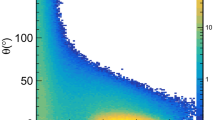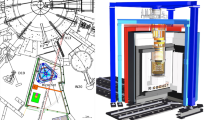Abstract
The nature of background processes accompanying astrophysical nuclear reactions induced by hydrogen, helium, and neon ions in deuterated targets with small cross sections has been studied in calculations and experiments. The experiments have been performed at a Hall pulsed plasma accelerator in the ion energy range of 26–32 keV. The yield of background neutrons and γ-quanta with energies below 4 MeV in the proton-induced D(p, γ)3He reaction is primarily due to the presence of a natural impurity of gaseous deuterium in gaseous hydrogen and the chain of D(D, 3He)n → (n, γ) or (n, n'γ) reactions. A small contribution comes from the chain of D(1H, 1H)D → D(D, 3He)n → (n, γ) or (n, n'γ) reactions. It has been shown that background neutrons and γ-quanta from the D(4He, γ)6Li reaction are entirely due to the chain of D(4He, 4He)D → D(D, 3He)n → (n, γ) or (n, n'γ) reactions. It has been shown that the yield of neutrons and γ-ray photons detected at the interaction of neon ions with deuterated targets is also entirely due to the chain of elastic- scattering reactions of neon ions on deuterons in the target and to subsequent inelastic processes of interaction of deuterons accelerated at elastic scattering with other deuterons of the target. The main contribution to the yields of background neutrons and γ-quanta comes from doubly charged neon ions. The main conclusion is that the explanation of the yield of neutrons and γ-quanta at the interaction of hydrogen, helium, and neon ions with deuterated targets does not require “exotic” theoretical models.
Similar content being viewed by others
References
D. N. Schramm and R. V. Wagoner, Ann. Rev. Nucl. Sci. 27, 37 (1977).
H. Reeves, Rev. Mod. Phys. 66, 193 (1994).
B. D. Fields, Ann. Rev. Nucl. Part. Sci. 61, 47 (2011).
R. H. Cyburt, B. D. Fields, K. A. Olive, and Tsun-Han Yeh, Rev. Mod. Phys. 88, 015004 (2016).
M. Asplund, D. L. Lambert, P. E. Nissen, F. Primas, and V. V. Smith, Astrophys. J. 644, 229 (2006).
J. C. Howk, N. Lehner, B. D. Fields, and G. J. Mathews, Nature 489, 121 (2012).
K. Lind, J. Melendez, M. Asplund, R. Collet, and Z. Magic, Astron. Astrophys. A 96, 554 (2013).
R. N. Boyd, C. R. Brune, G. M. Fuller, and C. J. Smith, Phys. Rev. D 82, 105005 (2010); arXiv:1008.0848 [astro-ph.CO].
H. Dapo, I. Boztosun, G. Kocak, and A. B. Balantekin, Phys. Rev. C 85, 044602 (2012).
L. Marcucci, K. Nollet, R. Schiavilla, and R. Wiringa, Nucl. Phys. A 777, 111 (2006).
J. Kiener, H. J. Gils, H. Rebel, S. Zagromski, G. Gsottschneider, N. Heide, H. Jelitto, J. Wentz, and G. Baur, Phys. Rev. C 44, 2195 (1991).
F. Hammache, M. Heil, S. Typel, et al., Phys. Rev. C 82, 065803 (2010).
F. E. Cecil, J. Yan, and C. S. Galovich, Phys. Rev. C 53, 1967 (1996).
M. Anders et al. (LUNA Collab.), Phys. Rev. Lett. 113, 042501 (2014).
A. M. Mukhamedzhanov, L. D. Blokhintsev, and B. F. Irgaziev, Phys. Rev. C 83, 055805 (2011).
Yu. B. Burkatovskaya, V. M. Bystritskii, G. N. Dudkin, A. R. Krylov, A. S. Lysakov, S. Gazi, I. Guran, B. A. Nechaev, V. N. Padalko, A. B. Sadovskii, Yu. G. Tuleushev, M. Filipovich, and A. V. Filippov, Phys. Part. Nucl. Lett. 13, 190 (2016).
V. M. Bystritsky, G. N. Dudkin, A. R. Krylov, S. Gazi, J. Huran, B. A. Nechaev, V. N. Padalko, A. B. Sadovsky, Yu. Zh. Tuleushev, M. Filipowicz, and A. V. Philippov, Nucl. Instrum. Methods Phys. Res. A 825, 24 (2016).
M. Anders, D. Trezzi, A. Bellini, et al. (LUNA Collab.), Eur. Phys. J. A 49, 28 (2013).
A. N. Zinoviev, Nucl. Instrum. Methods Phys. Res. B 354, 308 (2015).
V. I. Vysotskii and M. V. Vysotsky, J. Exp. Theor. Phys. 120, 246 (2015).
V. M. Bystritsky, Vit. M. Bystritskii, G. N. Dudkin, et al., Nucl. Phys. A 889, 93 (2012).
V. M. Bystritsky, Vit. M. Bystritskii, G. N. Dudkin, et al., JETP Lett. 99, 497 (2014).
A. V. Bagulya, O. D. Dalkarov, M. A. Negodaev, A. S. Rusetskii, A. P. Chubenko, V. G. Ralchenko, and A. P. Bolshakov, Nucl. Instrum. Methods Phys. Res. B 355, 340 (2015).
A. V. Bagulya, O. D. Dal’karov, M. A. Negodaev, A. S. Rusetskii, A. P. Chubenko, and A. L. Shchepetov, Bull. Lebedev Phys. Inst. 40, 282 (2013).
A. V. Bagulya, O. D. Dalkarov, M. A. Negodaev, A. S. Rusetskii, and A. P. Chubenko, Phys. Scripta 90, 074051 (2015).
E. E. Salpeter, Phys. Rev. 88, 547 (1952).
H.-S. Bosch and G. M. Hale, Nucl. Fusion 32, 611 (1992).
L. D. Landau and E. M. Lifshitz, Course of Theoretical Physics, Vol. 1: Mechanics (Nauka, Moscow, 1973; Pergamon Press, New York, 1988).
V. M. Bystritsky and F. M. Pen’kov, Phys. At. Nucl. 66, 77 (2003).
H. J. Assenbaum, K. Langanke, and C. Rolfs, Z. Phys. A 327, 461 (1987).
C. E. Moore, Ionization Potentials and Ionization Limits Derived From the Analysis of Optical Spectra, NSRDS–NBS 34 (Washington, 1970).
Author information
Authors and Affiliations
Corresponding author
Additional information
Original Russian Text © V.M. Bystritsky, V.A. Varlachev, G.N. Dudkin, A.S. Nurkin, B.A. Nechaev, V.N. Padalko, F.M. Pen’kov, Yu.Zh. Tuleushev, M. Filipowicz, A.V. Philippov, 2017, published in Zhurnal Eksperimental’noi i Teoreticheskoi Fiziki, 2017, Vol. 152, No. 5, pp. 877–889.
Rights and permissions
About this article
Cite this article
Bystritsky, V.M., Varlachev, V.A., Dudkin, G.N. et al. Study of background processes with the formation of neutrons in nuclear reactions in the energy range of 26–32 kev. J. Exp. Theor. Phys. 125, 741–751 (2017). https://doi.org/10.1134/S1063776117100041
Received:
Published:
Issue Date:
DOI: https://doi.org/10.1134/S1063776117100041




